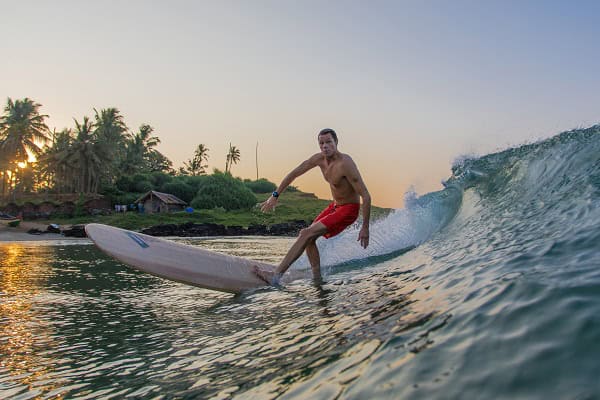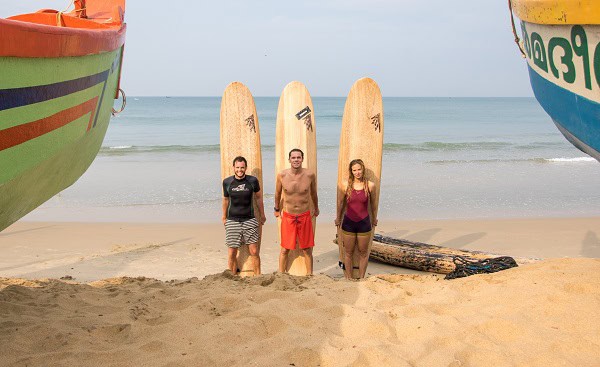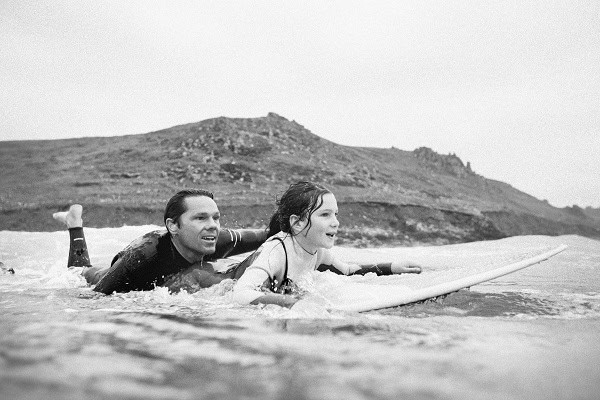Could riding the waves be the ultimate meditation? Professional surfer and author Sam Bleakley suggests what the oceans can teach us about our place in the natural world
What role has surfing played in your life?
Surfing has played a central role in my life and career. Along the way, the ocean has knocked me senseless, torn ligaments, ruined my sinuses, reduced my spectrum of hearing, dragged me across infectious live coral reefs, held me down so I am close to drowning, and engineered a face-to-face encounter with a tiger shark. But such bruises generate a kind of wisdom, and they are suffered because the rewards of surfing are immense. Surfing has opened me up, split my skin and widened my horizons but closed me down too, because any obsession restricts your involvement in other aspects of life. Travel has permanently reddened my eyes, but layered experience upon experience in building character. The sea has focused my restless personality and given me calm.
What are the stereotypes about surfers and what are surfers really like?
I have great old surfing T-shirt that simply reads ‘No brains, no headaches’ in bright print across the back, accompanied by three cartoon pineapple faces with shades and sun-soaked smiles. “No worries!” as the Australians say. It was a carefully constructed, tongue-in-cheek dig at the stereotype that surfers are fun-loving, happy-go-lucky opportunists with water on the brain – a beatnik tribe of anti-intellectuals.
Surfing brings you face to face with the raw beauty of nature at different volumes and tone
Whether beach bums in the 1950s, hippies and drop-outs in the 1960s, ‘animals’ in the 1970s shortboard era, aggro-punks in the 1980s, or airheaded fashion victims, surfing and academia do not immediately seem to mix. Yet there are role models: a number of champion surfers went on to become leading academics, mainly oceanographers, most famously Ricky Grigg in Hawaii. Consider the massive number of variables that enable surfing: the meteorological and oceanographic phenomena that generate swell, the geographic location of the break, the geology of the reef or beach, not to mention the global industry that has supplied the wetsuit and chemicals-based surfboard.
Surfing has an expressive side, and this is just as open to study and debate. Binding it all is a collective folk wisdom from the surf culture. While surfers intuitively know about wave action and its relationship to bottom shape, these links are still unexplained fully by science.
Organised, lay surfing knowledge is a great example of practice expertise in action, rather than ‘specialist’ knowing – a tacit knowledge developed through experience, but hard to articulate. The rewards for predicting the perfect wave at the perfect time are considered the perfect experience.

Image: Down the Line Photography/Peter Chamberlain
What is ‘mindfulness for surfers’?
Moments of stillness can help us to regain a sense of self, of composure or centring. Surfing as mindfulness, however, does something a little different. It does not simply take us inside ourselves to find a still centre, but rather orients us within the environment to find place. We are immersed in water and the salt-soaked zone just above the sea’s skin. Around us, terns dive and fish jump. We are active, alert and intent on balance.
Mindfulness in surfing is a moving out of mind into the world, into an acute sense of what the environment demands of us – where winds, currents, beach shapes, wave types and lunar-tidal movements meet.
We are immersed in water and the salt-soaked zone just above the sea’s skin. We are active, alert and intent on balance
Surfing becomes addictive and you follow, but it is probably better to think of this as a calling, a vocation – a ‘call of the wild’ translated from the Yukon to any surfable coastline. As a professional surfer who also makes a living from travel writing, I have followed the pursuit around the world and clocked up many guilty air miles. It is common to see beaches openly used as dumps and toilets, littered with plastics.
But there is always choice. Most surfers are naturally friends of the ocean – they are already badged, stained by salt residues. But, as ever, there are contradictions at work. Some surfing communities are infamous for their aggressive localism, protecting ‘their’ local break from visitors. This is plain nonsense – no group of people ‘owns’ the ocean in this way, and surfers must face this fact.
As the poet Wallace Stevens wrote: “The world is presence, not force.” The world does not set out to control us, it merely presents itself in all its glory and moods, yet we are bent on controlling it and our methods have been crude, destructive and are now boomeranging back with a vengeance.
Surfing has a rich history: what examples in the sport’s past would you mention to those new to it?
From ‘laid-back’ to ‘post-punk-hipster’, lifestyles have been shaped around the ‘cool’ of surfing. In the long shadow of Polynesian royalty and the ocean-savvy (and tourist-savvy) Waikiki ‘Beachboys’ of the early 1900s, Californian beach culture boomed in the 1960s because of climate, Hollywood glamour, the cult of youth, and aerospace technology used in surfboards. The bright coloured foam and fibreglass ‘Malibu’ confirmed a shift of gravity from Honolulu to Los Angeles. Riding styles evolved from stiff stances on heavy wooden boards to dance-like ‘hotdogging’ and ‘hanging ten’ toes over the front of lighter nine feet ‘longboards’.
In ancient Hawaii surfing was ‘the sport of kings and queens’. In post-war America, surfing gained an identity where ‘all can be kings and queens’. California was about aspiration, lithe bodies and the fizz of the new. Extreme sports and bikinis were born in this ferment, putting adrenaline, risk and style in an alchemical mix. In its wake came slang (‘rad, dude’), reverberating electric guitar and drum based surf music (Dick Dale), clothes (Hawaiian print boardshort baggies, cotton T-shirts with screen printed logos), magazines (with in-your-face photography and cutting-edge graphics) and films whetting appetites for travel and discovery.
In the late 1960s a core of Australians inspired the ‘shortboard revolution’, minds fuelled by psychedelics and yoga. The ‘tube’ (under the curling part of the wave) was now the spatial Nirvana of surfing, demanding exploration to the fastest waves. As boards got lighter, the seeds of professional and aerial surfing were spawned in the 1970s and 1980s. ‘Hot’ beach cultures followed: Byron Bay, Kuta Beach. Surfers were pioneers in Mauritius, Fiji, Liberia, the Philippines and Hainan, China: a model for those who want ‘off the beaten track’ and now ‘far out’ cold water surf holidays (in Iceland).

Image: Down the Line Photography/Peter Chamberlain
Why is surfing a great way to reconnect with nature?
For more than 2,000 years the western world has developed techniques of focus on the self and the inward life. The invention of autobiography as a literary genre in the 18th century and personal-confessional styles across all media – from kiss-and-tell journalism, to selfies and YouTube videos – has, arguably, dried up our receptivity to the outer world. We have instead become acutely sensitive to the inner life. As a result, we have an egological surplus and an ecological crisis. We need to recover sensitivity towards the world around us – its cries and pleasures, its sufferings and beauties. Surfing is an ideal way to do this as a mindfulness given by nature. The saltwater soul of surfing is to be mindful of nature’s body as we cultivate a ‘bodymind’.
As a novice, you will spend far more time spilled into the sea than standing on your board surfing a wave, and so the apprenticeship into an ecological perception, or being mindful of nature’s body, can be tough and uncomfortable – especially in cold seas and even in state-of-the-art wetsuits. As expertise develops, the surfer becomes a connoisseur of the oceans, tutored and formed by them.
We need to recover sensitivity towards the world around us – its cries and pleasures, its sufferings and beauties. Surfing is an ideal way to do this
The sea and its waves are largely untouched by human culture in its energies and forms, even if there is pollution and rising sea levels through global warming. Surfing brings you face to face with the raw beauty of nature at different volumes and tones. As one is taught and shaped by the ocean – its waves, currents, tides, sea life, colours, temperatures, forms and patterns – so one becomes more tuned to its needs and then more ecologically minded and sensitive.
Surfing is a great vehicle for getting us right into the heart of the oceans’ and coastlines’ workings so that they can teach us how to care for them, and above all, how to be mindful.
Why did you write this book, now?
Leaping Hare Press approached me about the book as part of their mindfulness series. It was an exciting opportunity to fuse environmental and cultural references with surfing and travel. When I was a kid, my dad told me a Maori folk tale about a big-headed villager who boasted that he could bring home a whale that would feed the whole community for a winter. The young man tricked the whale into letting him ride it, just like a surfboard, lulling the whale into going straight into shore so that it beached itself and died. The whale was a totem animal for the neighbouring village and they were shocked when they heard how the whale had been tricked, as they would never eat their totem or treat it badly.
Many surfers may be just like the big-headed villager – unaware of how their activities mistreat the environment and how we abuse our animal relatives. Mindful surfers should have the opposite mindset – respectful of sea life and acutely aware of the environment. They should live somewhere between fish and bird, sitting on their surfboards.
There is a powerful lesson to be learned from all sea life, so well adapted. Humans work against currents and winds, powering machines to journey in the straightest possible line. But this is hugely inefficient. Turtles and sharks use the currents to travel. Dolphins in pods leap so high because they work collaboratively to produce strong vortices and eddies in the water that supplement their muscle power, allowing them to burst higher and further than their body mass should allow.
Mindfulness and Surfing: Reflections for Saltwater Souls by Sam Bleakley is out now, from Leaping Hare Press.
Featured image: Down the Line Photography/Peter Chamberlain

